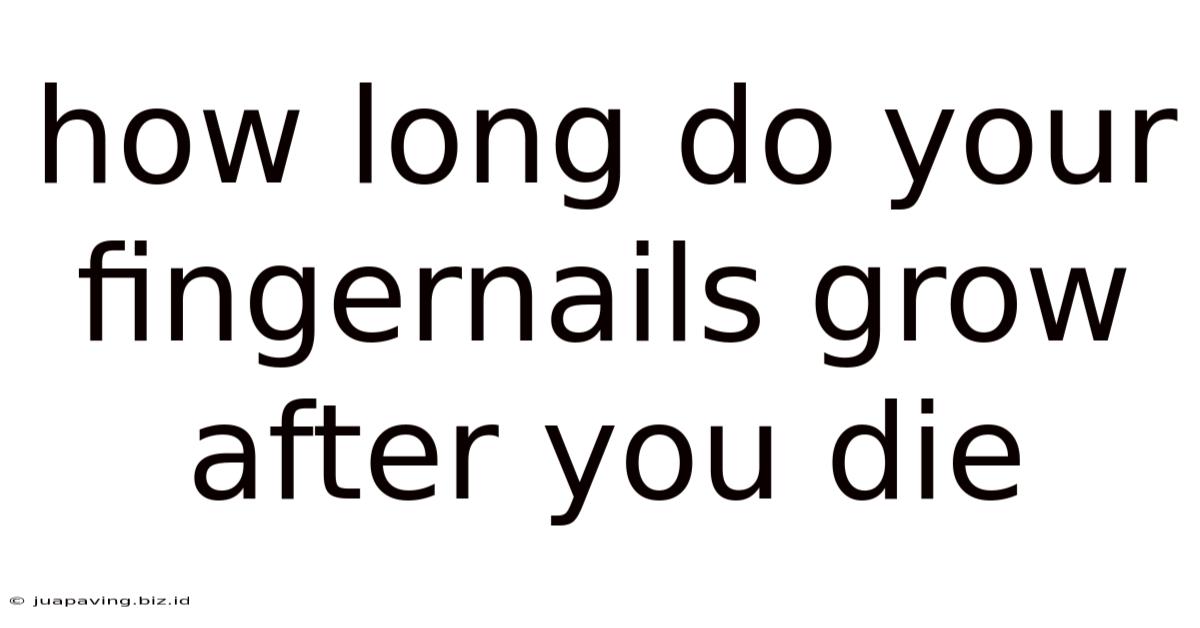How Long Do Your Fingernails Grow After You Die
Juapaving
May 09, 2025 · 4 min read

Table of Contents
How Long Do Your Fingernails Grow After You Die? A Deep Dive into Postmortem Changes
The question of whether fingernails continue to grow after death is a common one, fueled by folklore and occasional misunderstandings of postmortem changes. The short answer is no, fingernails do not grow after death. However, the appearance of growth can be deceiving, leading to this persistent myth. This article will explore the biological processes behind this misconception, examining the factors that contribute to the illusion of postmortem nail growth and delving into the broader subject of postmortem changes in the body.
Understanding the Biology of Nail Growth
Before addressing the postmortem scenario, let's understand how fingernails grow in life. Fingernails, like hair, are composed of a protein called keratin. Keratin is produced by specialized cells in the nail matrix, a region located beneath the cuticle. These cells constantly divide and produce new keratin, pushing older keratin outwards, resulting in the visible growth of the nail. This process requires a continuous supply of nutrients and oxygen, delivered via the circulatory system. Crucially, nail growth is directly dependent on the functioning of living cells.
The Cessation of Biological Processes After Death
Upon death, the body's biological processes cease. The circulatory system, responsible for delivering nutrients and oxygen to the nail matrix, shuts down. Cell division stops, and the production of new keratin ceases. Therefore, no new nail material is formed after death. The appearance of longer nails is due to a different set of factors.
The Illusion of Postmortem Nail Growth: Dehydration and Retraction
The illusion of postmortem nail growth is primarily attributed to two factors: dehydration and skin retraction.
Dehydration's Role
After death, the body begins to dehydrate. This dehydration affects the soft tissues surrounding the nails, including the skin. As the skin around the nails retracts, the nails appear longer relative to the shrinking surrounding tissue. This effect is most pronounced in the fingers and toes, creating the illusion that the nails have grown. This is not actual growth; it's a change in the relative proportions of the nail and surrounding skin.
Skin Retraction: Exposing More of the Nail
Dehydration also contributes to skin retraction. As the body loses moisture, the skin shrinks and pulls away from the underlying tissues, including the nail bed. This process can expose more of the nail plate, further enhancing the illusion of growth. The skin around the nails becomes drier and tighter, pulling back and making the nails seem longer than they actually were at the time of death.
Other Postmortem Changes Affecting the Appearance of Fingernails
Beyond dehydration and skin retraction, other postmortem changes can affect the appearance of fingernails and contribute to the misconception of growth. These include:
Decomposition and Tissue Breakdown:
As decomposition progresses, the body's tissues begin to break down. This process can affect the skin surrounding the nails, leading to further retraction and changes in the apparent length of the nails. While decomposition itself doesn't cause nail growth, it can amplify the visual effects of dehydration and retraction.
Environmental Factors:
External factors, such as temperature and humidity, can also influence the rate of dehydration and skin retraction. Higher temperatures and lower humidity generally accelerate the dehydration process, potentially making the illusion of nail growth more pronounced.
Debunking the Myth: Scientific Evidence and Forensic Implications
The idea of postmortem nail growth is a persistent myth, lacking scientific basis. Forensic scientists and anthropologists understand that the apparent increase in nail length is a result of the postmortem changes described above, not actual growth. Forensic investigations often rely on accurate estimations of postmortem interval (PMI), and the misconception of nail growth could lead to misinterpretations of time since death.
The Importance of Understanding Postmortem Changes in Forensic Science
Accurate assessment of postmortem changes is crucial in forensic investigations. Understanding the processes of dehydration, skin retraction, and decomposition allows forensic experts to estimate the time of death more accurately. Misinterpreting the apparent lengthening of nails due to dehydration as actual growth could significantly impact the accuracy of forensic investigations.
Conclusion: Separating Fact from Fiction
In conclusion, fingernails do not grow after death. The perception of growth is entirely due to the postmortem changes in the surrounding tissues, mainly dehydration and skin retraction. The shrinkage of the skin around the nails creates an illusion of increased length, a misconception that has persisted due to a lack of understanding of these postmortem processes. This understanding is crucial not only for dispelling a common myth but also for ensuring the accuracy and reliability of forensic investigations. Remember, the cessation of biological processes after death means no further production of keratin, the fundamental component of nails, making postmortem nail "growth" a purely visual phenomenon. Next time you encounter this question, you'll be armed with the scientific facts to explain why the answer is definitively "no."
Latest Posts
Latest Posts
-
Como Se Escribe 880 En Ingles
May 09, 2025
-
Visual Acuity Is Greatest At The Fovea Of The Eye
May 09, 2025
-
How Many Lines Of Symmetry Does A Scalene Triangle Have
May 09, 2025
-
How Are Gametes Produced By Bryophytes
May 09, 2025
-
What Is The Function Of Chlorophyll In Photosynthesis
May 09, 2025
Related Post
Thank you for visiting our website which covers about How Long Do Your Fingernails Grow After You Die . We hope the information provided has been useful to you. Feel free to contact us if you have any questions or need further assistance. See you next time and don't miss to bookmark.